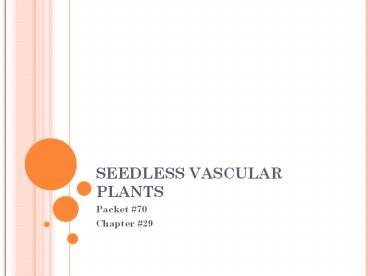SEEDLESS VASCULAR PLANTS - PowerPoint PPT Presentation
Title:
SEEDLESS VASCULAR PLANTS
Description:
SEEDLESS VASCULAR PLANTS Packet #70 Chapter #29 * * * * * What are the similarities between the bryophytes and the seedless vascular plants (ferns)? – PowerPoint PPT presentation
Number of Views:904
Avg rating:3.0/5.0
Title: SEEDLESS VASCULAR PLANTS
1
SEEDLESS VASCULAR PLANTS
- Packet 70
- Chapter 29
2
THE THEORY OF EVOLUTION CONNECTION
- Seedless vascular plants arose in the
Carboniferous Period 420 360 mya - Phylum Rhinophyta are known as the oldest
seedless vascular plants - These organisms left relics, fossils and coals
- Scientists believe that seed plants were present
during this evolutionary time period but were not
dominant. - Seedless vascular plants became important as the
swamps dried up and the global climate cooled.
3
TYPES OF SEEDLESS VASCULAR PLANTS
- There are four phyla of seedless vascular plants.
- Phylum Polypodiophyta
- Ferns
- Phylum Psilotophyta
- Whisk ferns
- Phylum Equisetophyta
- Horsetail
- Phylum Lycophyta
- Club Mosses
4
IMPORTANT INFORMATION FOR VASCULAR PLANTS
5
LEAVES OF VASCULAR PLANTS
- Leaves of Vascular Plants
- Microphylls
- There are two types of leaves that may be found
on seedless vascular plants - Microphylls
- Small and have a single vascular strand
- Club mosses
- Megaphylls
- Larger and have more than one vascular strand
- Plants needed a flattened blade with more stomata
for gas exchange - Ferns, horsetails and seed plants
6
KEYWORDS OF VASCULAR PLANTS
- Homospory
- The production of one kind of spore
- Bryophytes
- Whisk ferns
- Horsetails
- Most club mosses
- Most ferns
- Spore gives rise to gametophyte plants that
produce both egg and sperm cells.
7
KEYWORDS OF VASCULAR PLANTS II
- Heterospory
- Production of two kinds of spores
- Microspores
- Give rise to male gametophytes that produce sperm
cells - Megaspores
- Give rise to female gametophytes that produce
eggs. - Occurs in
- Certain club mosses
- Certain ferns
- ALL SEED PLANTS.
- The evolution of heterospory was an essential
step in the evolution of seeds.
8
SEED VASCULAR PLANTSFERNS
9
PHYLUM PTEROPHYTASUBPHYLUM POLYPOIOPHYTATHE
FERNS
- Largest and most diverse group of seedless
vascular plants. - Have xylem and phloem tissue
- Most have true roots
- More than 12,000 species have been described.
10
PHYLUM PTEROPHYTASUBPHYLUM POLYPOIOPHYTATHE
FERNS
- Almost all species are homosporous
- All have megaphylls.
- Found primarily in moist tropical habitats
- Few are aquatic
11
FERNSFEATURES THAT DISTINGUISH FERNS AND OTHER
SEEDLESS VASCULAR PLANTS FROM ALGAE AND
BRYOPHYTES.
- Comparison to Bryophytes
- Ferns have vascular tissue
- Ferns have a dominant sporophyte generation.
- As in bryophytes, reproduction in ferns depends
on water as a transport medium for their motile
sperm cells.
12
REPRODUCTIVE CYCLE OF FERNS
13
PHYLUM PTEROPHYTASUBPHYLUM POLYPOIOPHYTATHE
FERNS
- Figure 29.12Page 585
- Ferns display alternation of generation and they
have a dominant sporophyte generation - Fern bodies consist of a rhizome (an underground
stem), roots, and leaves (megaphylls).
14
PHYLUM PTEROPHYTASUBPHYLUM POLYPOIOPHYTATHE
FERNS
- Sprophytes have roots, rhizomes and leaves that
are megaphylls. - Leaves, or fronds, bear sporangia in clusters
called sori. - Meiosis of sporangia produces haploid spores.
15
PHYLUM PTEROPHYTASUBPHYLUM POLYPOIOPHYTATHE
FERNS
- Spore germinates and grow via mitosis into a
gametophyte called haploid prothallus. - Heart shaped and lacks vascular tissue
- Anchored by rhizoids
- Bears antheridia and archegonia
- Water is still required for transportation of the
flagellated sperm to the archegonium - Zygote grows into free-living sporophyte plant.
16
SEEDLESS VASCULAR PLANTSWHISK FERNS
17
PHYLUM PTEROPHYTA SUBPHYLUM PSILOTOPHYTATHE
WHISK FERNS
- Simplest vascular plants
- Lack true roots and leaves
- Consists of dichotomously branching rhizomes
- Have erect stems.
- Homosporous sporophylls.
18
SEEDLESS VASCULAR PLANTSHORSETAILS
19
PHYLUM PTEROPHYTASUBPHYLUM EQUISETOPHYTATHE
HORSETAILS
- Sporophytes have roots
- Rhizomes
- Aerial stems
- Hollow and jointed
- Leaves that are reduced megaphylls
20
SEEDLESS VASCULAR PLANTSCLUB MOSSES
21
PHYLUM LYCOPHYTATHE CLUB MOSSES
- Small plants with rhizomes and short erect
branches - Extant species have true roots and leaves that
are microphylls.
22
REVIEW
23
REVIEW
- Students
- List potential examination questions and/or here,
and on following slides, based on the packet.































